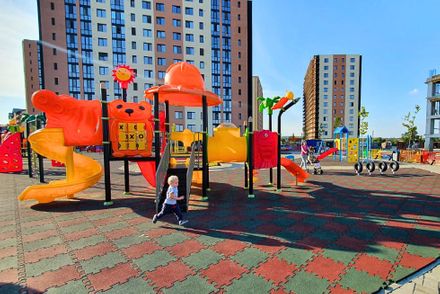Public playgrounds are inclusive spaces, specially designed for every child in the community to enjoy the charm of play hours alongside other kids of their age, regardless of their social status, race, color, or education. These areas have a multifaceted role in the development of children, which is why the way they are arranged is crucial.
The Importance of Public Playgrounds for Children's Development
Public playgrounds have a crucial importance in children's development from various perspectives:
1. Physical Development: Public playgrounds offer children the opportunity to move and develop their gross and fine motor skills. They can run, jump, or climb on various outdoor play equipment installed in the area, which contributes to improving coordination and balance.
2. Social Component: Accessible playgrounds for all members of a community promote high levels of inclusivity. Through play, children learn to interact with others and resolve conflicts.
3. Friendship and Empathy: Playgrounds provide an ideal setting for children to make new friends and learn empathy, regardless of their social status. Playing together allows them to express their emotions more freely.
4. Stimulating Creativity: Playgrounds allows children to use their imagination to create new and interesting narratives, which is crucial for stimulating creativity.
Choosing the Right Location for a Public Playground
The most important aspect is accessibility and visibility of the location. The playground should be easily accessible to families, preferably in a central area or well-connected by public transportation. This is convenient for parents, especially those coming after work.
Safety is another key aspect when choosing the location. Analyzing the area for potential hazards such as heavy traffic, pollution, wild animals, or other threats to children's safety is essential.
Terrain characteristics are also crucial. A flat and stable terrain is ideal for a public metal playground. A good exposure to the sun and shaded areas to protect children on hot days are also preferred.
Legislative Aspects and Regulations for Playground Design
Local authorities can issue additional regulations, depending on the specific needs and characteristics of each city or locality. Regarding safety standards, it is important for public playgrounds to comply with European standards EN 1176 and EN 1177.
These standards, established by the European Committee for Standardization, define safety and quality requirements for playground equipment and surfaces. For example, equipment must be built from durable materials, have rounded edges, and include shock-absorbing systems. Additionally, the distance between equipment must be sufficient to prevent collisions and accidents.
In conclusion, the design and maintenance of public playgrounds involve compliance with national and local legislative aspects and European safety standards. Furthermore, authorized ISCIR installation is an important step to ensure that equipment is installed and maintained in accordance with regulations, making the playground safe for users.
Accessibility in public playgrounds is also an important aspect to consider. Individuals with mobility issues should have easy access to these spaces and be able to use disability-friendly equipment safely.
How to Choose the Right Equipment for a Public Playground
Selecting the appropriate equipment for a public playground is extremely important to ensure the safety and development of children. Here are some key ideas on how to make this selection:
The equipment should be suitable for the average age of the user group. For very young children, slides, swings, or play complexes are ideal options. For slightly older children, you can install outdoor trampolines or even sports facilities around the perimeter.
Playground equipment must adhere to certain safety standards to prevent accidents. These standards may include aspects related to the maximum height of assemblies, the distance between them, the materials used in their construction, or the surface covering the ground.
The best playground equipment should withstand weather conditions, wear and tear, and high-intensity use. Additionally, it should be easy to maintain to remain safe and attractive in the long term. In this regard, establishing a maintenance/checking program is particularly important.
Involving the Community in Playground Design and Maintenance
Involving the community in the process of playground design and maintenance leads to a better understanding of the needs and desires of families with young children. It fosters a sense of responsibility towards these spaces and promotes community cohesion.
Various methods can engage residents, such as brainstorming and planning sessions to gather ideas and suggestions for the project. Community members can also volunteer for construction and maintenance activities, strengthening their bonds and connections within the community.
In conclusion, designing a public playground for children is not a simple process; it involves important considerations, from identifying a suitable location and complying with legislative regulations to choosing appropriate equipment and ensuring the safety of the children. Maintenance and community involvement play a crucial role in the success and sustainability of these spaces.




































































































































